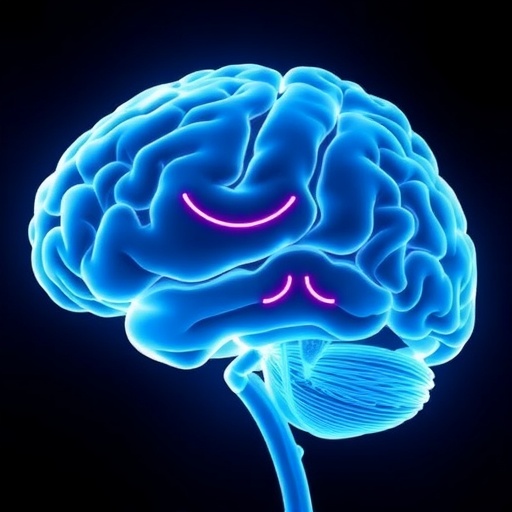
In a groundbreaking study published in “Military Medicine Research,” researchers are making significant strides in understanding lumbar disc degeneration through the innovative application of machine learning techniques. The paper, authored by Jin et al., introduces a novel clinical-transcriptomic classification system that could revolutionize the way healthcare professionals diagnose and treat patients suffering from lumbar disc issues. With the prevalence of such conditions rising globally, the urgency for effective diagnostic methods has never been greater.
At the crux of this research lies the integration of machine learning algorithms into the realm of clinical medicine. By analyzing vast amounts of transcriptomic data—essentially, the complete set of RNA transcripts produced by the genome under specific circumstances—the researchers were able to uncover patterns previously hidden within the complexity of genetic influences on lumbar disc health. This approach represents a significant departure from traditional diagnostic methods, which often rely on physical examinations and limited imaging techniques that fail to capture the full biological picture.
Lumbar disc degeneration is a common ailment that affects millions around the globe. As we age, the intervertebral discs in our spines can begin to lose hydration and elasticity, leading to conditions such as herniated discs and chronic back pain. Unfortunately, conventional diagnostic methods frequently fall short, making it difficult for physicians to determine the precise nature and extent of degeneration in individual patients. The study by Jin and colleagues aims to provide a more accurate classification system that could potentially lead to tailored treatment options, thereby improving patient outcomes.
The innovative blend of machine learning with transcriptomics reveals an exciting pathway for the future of medicine. By employing advanced algorithms capable of sifting through complex datasets, the researchers were able to classify lumbar disc degeneration into distinct categories based on molecular signatures. This classification not only enhances understanding of the underlying biological mechanisms associated with degeneration but also facilitates a more personalized approach to treating affected individuals.
Machine learning techniques like supervised and unsupervised learning were pivotal in analyzing data collected from patient samples. The research team meticulously trained their algorithms to recognize specific patterns in gene expression linked to varying degrees of disc degeneration. The ultimate objective is to move away from a one-size-fits-all treatment approach and, instead, offer therapies that are more effective and specifically tailored to the individual’s unique genetic makeup.
One of the most compelling aspects of this research lies in its potential to inform clinical decision-making. Traditional classifications of lumbar disc degeneration often leave practitioners at a loss when it comes to guiding treatment plans. However, armed with this newly developed machine-learning-enhanced classification system, clinicians can gain insight into the molecular characteristics of a patient’s condition. This knowledge could lead to more informed choices about surgical interventions, physical therapy, and other therapeutic modalities.
While the promise of this research is immense, the study is not without its limitations. The researchers are keenly aware that the transition from bench to bedside is fraught with challenges. Validating these machine-learning models within larger, heterogeneous populations will be paramount for ensuring their effectiveness in diverse clinical scenarios. Moreover, as predictive models evolve, ongoing refinements will be necessary to capture new insights and improve accuracy.
Another important consideration is the integration of these findings into medical practice. Hospitals and clinics will need to invest in training personnel to understand and utilize machine learning outputs effectively. The collaboration between data scientists and healthcare providers will be crucial for interpreting complex results, fostering a culture that embraces technological advancements to improve patient care.
The implications of this research are vast, extending beyond just the realm of lumbar disc degeneration. If successful, the methodology pioneered by Jin and colleagues could serve as a blueprint for analyzing other musculoskeletal disorders and diseases. This study hints at a future where machine learning not only enhances diagnostic capabilities but also accelerates discoveries in personalized medicine across a range of healthcare specialties.
Public health implications are equally noteworthy. As lower back pain remains a leading cause of disability worldwide, advancing the diagnosis and treatment of lumbar disc degeneration could alleviate a significant burden on healthcare systems globally. Early and accurate diagnosis enabled by machine learning could lead to decreased healthcare costs through reduced unnecessary treatments and improved long-term patient outcomes.
Moreover, the engagement of the military medicine sector in such research highlights a commitment to advancing health outcomes for service members, who often face unique physical demands and risks related to musculoskeletal injuries. By addressing conditions like lumbar disc degeneration in the military population, findings could potentially translate to improved readiness and performance among troops, as well as enhanced quality of life for veterans.
As Jin et al. continue their work, the scientific community eagerly anticipates further developments in this field. Every breakthrough brings researchers closer to resolving complexities surrounding degenerative diseases. The hope is that with a deeper understanding of the molecular underpinnings of such conditions, new therapeutic options may emerge, paving the way for minimally invasive procedures and innovative recovery protocols.
In conclusion, Jin et al.’s research stands as a testament to the power of interdisciplinary collaboration between computer science and clinical medicine. It introduces a promising frontier in the diagnosis and management of lumbar disc degeneration through machine learning and transcriptomic analysis. As researchers continue to validate and refine their models, the potential for transformative change in patient care becomes ever more tangible. This study not only sheds light on a prevalent health issue but also symbolizes the dawn of a new era in personalized medicine, where data-driven approaches may one day lead to unprecedented advancements in how we diagnose, treat, and ultimately understand musculoskeletal disorders.
In summary, the work being done by Jin and his team holds immense promise for the future of clinical practice, as their approach to lumbar disc degeneration could set the stage for further innovations across various medical disciplines, reinforcing the need for ongoing research and collaboration in this vital area of healthcare.
Subject of Research: Lumbar Disc Degeneration and Machine Learning
Article Title: Clinical-transcriptomic classification of lumbar disc degeneration enhanced by machine learning.
Article References:
Jin, HJ., Lin, P., Ma, XY. et al. Clinical-transcriptomic classification of lumbar disc degeneration enhanced by machine learning.
Military Med Res 12, 54 (2025). https://doi.org/10.1186/s40779-025-00637-9
Image Credits: AI Generated
DOI: 10.1186/s40779-025-00637-9
Keywords: Lumbar disc degeneration, machine learning, transcriptomics, personalized medicine, clinical classification, healthcare innovation.
Tags: advancements in spinal health researchAI in lumbar disc degenerationchronic back pain managementclinical-transcriptomic classificationdiagnosing lumbar disc issuesgenetic influences on lumbar healthinnovative diagnostic methods for back painintegration of AI in medical diagnosticsmachine learning in healthcarerevolutionizing healthcare with AIRNA transcript analysis in medicinetreating lumbar disc degeneration




